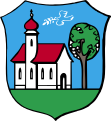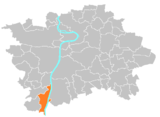Zbraslav
| Praha-Zbraslav | |||
|---|---|---|---|
|
|||
| Basic data | |||
| State : |
|
||
| Region : | Hlavní město Praha | ||
| Municipality : | Praha | ||
| Area : | 984.86 ha | ||
| Geographic location : | 49 ° 58 ' N , 14 ° 23' E | ||
| Height: | 207 m nm | ||
| Residents : | 7,448 (March 1, 2001) | ||
| Postal code : | 156 00 | ||
| License plate : | A. | ||
| traffic | |||
| Street: | Prague - Mníšek pod Brdy | ||
| Railway connection: | Dobříš – Praha-Modřany | ||
| structure | |||
| Status: | district | ||
| Districts: | 2 | ||
| administration | |||
| Mayor : | Zuzana Vejvodová (as of 2015) | ||
| Address: | Zbraslavské náměstí 464 156 00 Praha 5-Zbraslav |
||
| Website : | www.mc-zbraslav.cz | ||

Zbraslav (German Königsaal ) is a district of Prague . It is located about ten kilometers south of Prague city center on the left side of the Vltava and belongs to the 5th district and the Prague 16 administrative district .
geography
Zbraslav is located in the northeastern foothills of the Hřebeny ( Brdykamm ) above the Vltava valley. The Lipanský potok (until 1829 a main arm of the Berounka (Miesa) river ) flows north of the village, and the Břežanský potok flows into the Vltava to the east. The Čihadlo (385 m nm) rises to the east, the Hradiště to the south-east, the Cukrák (411 m nm) to the southwest and the Havlín ( St. Gallus Mountain ) to the west .
Neighboring towns are Lahovice in the north, Komořany and Cholupice in the northeast, Nouzov, Závist and Točná in the east, Lhota and Zálepy in the southeast, Záběhlice in the south, Žabovřesky in the southwest, Peluněk and Buda in the west and Radotín in the northwest.
history
Zbraslav originally belonged to the sovereign estates and was transferred by Duke Vladislav I in 1115 to the Kladruby Monastery, which he founded . The monastery later exchanged the property with Bishop John II of Dražice for other goods. King Ottokar II , who valued the forest areas above the confluence of the Vltava and Miesa rivers as a hunting area, exchanged Zbraslav for other possessions at the diocese of Prague in 1268 and had a royal hunting farm built at the mouth of the Miesa and the Vltava. His successor Wenzel II founded the monastery Aula Regia on April 20, 1292 , which was settled by the Cistercian order in Waldsassen and its daughter monastery Sedletz with twelve monks under the abbot Konrad. In 1297 King Wenceslas II had the St. Build a collegiate church consecrated to Mother of God with a royal tomb. The basilica of the monastery became the burial place of the last members of the Přemyslids .
One of the most important late medieval historical sources in Bohemia, the Königsaaler Chronik (Chronicon Aulae regiae) , was started in the monastery Aula Regia by Abbot Otto von Thuringia (Abbot from 1312 to 1314) and continued by the most famous abbot of the monastery, Peter von Zittau . The monastery was an important center of education and humanism in Bohemia and the entire Holy Roman Empire . In 1400 Pope Boniface IX raised the parish church of St. Gallus and subordinated it to the monastery. The monastery was heavily devastated twice, in 1420 by the Hussites under Václav Koranda and in 1639 by the Swedes under General Banér . Before 1653 the Königsaal was raised to a market town .
Emperor Joseph II abolished the monastery in 1785. In 1787 the Bohemian sugar refinery in Königsaal near Prague, founded by Josef Edler von Sauvaigne, started operations as the first sugar factory in Bohemia. In 1827 Friedrich Kraft bought Heinrich zu Oettingen-Oettingen and Oettingen-Wallerstein the rule.
During the floods of 1829, the new tributary of the Berounka (Miesa) between Radotín and Modřany that was created in 1799 was washed away to form the main arm of the river. In the same year Friedrich Kraft zu Oettingen-Oettingen and Oettingen-Wallerstein had the new main river bed canalized with state support to avoid further breakthroughs and floods, so that at Königsaal only a branch flowed into the Vltava. In 1835 he founded the Königsaal trade school, which was also the first in Bohemia to teach in the Czech Republic.
The subservient market Königsaal or Zbraslaw , in Latin called Aula Regia , located in the Berauner district , consisted of 137 houses with 1420 inhabitants, including five Jewish families, in 1845. The royal palace with the chancellery and the apartment of the chief bailiff, the parish church of St. James d. Ä., The funeral and subsidiary church of St. Gallus and the school. There were four factories in the town: the kk state-privileged sugar refinery in Königsaal by Anton Richter with over 100 employees, the beet sugar factory in Königsaal by Anton Richter with 100 employees, the stately beet sugar factory with 80 employees and the soap factory in Königsaal by Anton Richter . There was also a stately brewery, a grand liquor house, a trade school, a post office, an inn and four other inns in the Königsaal . At Königsaal there was an overpass over the Vltava and a bridge over the old course of the Miesa. Four annual markets were held in the Königsaal, at which cutlery, ironware, pottery, furrier, rope, shoemaker and hat maker articles as well as about 100 horses, oxen and cows were offered for sale in around 70 stalls. Königsaal was the parish for Banie, Groß-Kuchel, Klein-Kuchel, Lahowitz, Lippan, Lipetz, Zabiehlitz and Zawobřesk. Until the middle of the 19th century, the Königsaal was the official seat of the rulers of the same name.
After the abolition of patrimonial rule , the Königsaal became the seat of a judicial district in 1850 . From 1868 the town belongs to the Smichow district . The old river bed of the Berounka (Miesa) between Buda, Peluněk, Žabovřesky and Zbraslav was completely thrown off in the flood of 1872, and the Lipanský potok was created . After the sugar factory ceased operations, Karl Friedrich zu Oettingen-Oettingen and Oettingen-Wallerstein bought their buildings in 1875 and had the factory buildings, the forge and the Gothic church of St. John the Baptist, which had served as a sugar store and hayloft, demolished.
Under the next owner of the manor, Cyril Bartoň-Dobenín , the monastery was restored and converted into a castle. In 1924 Žabovřesky and Záběhlice were incorporated, and the land registers were also combined. In 1967 Zbraslav was promoted to city. In 1974 it was incorporated into Prague as a district. The districts of Zbraslav and Lahovice were merged in 1990 to form the district of Praha-Zbraslav. In 1991 the district Zbraslav had 7151 inhabitants, ten years later 7,448 inhabitants in 1305 houses.
Local division
The district of Praha-Zbraslav is divided into the districts and cadastral districts of Lahovice and Zbraslav. The basic settlement units are Baně ( Banie ), Krňák, Lahovice ( Lahowitz ), Lahovičky ( Klein Lahowitz ), Lahovičky-soutok, Nad lomem, Peluněk ( Pelunek ), Strnady ( Strnad ), U vysílače, Závistice ( Sabieběhlitzlav ) and Zářávist ( Zawobresk ).
Attractions
- Zbraslav Castle , until 2009 it housed parts of the collections of the Prague National Gallery . Today only the southern part of the palace park is open to the public.
- Parish Church of St. James the Elder, it was built in 1640 as the new collegiate church of the Königsaal monastery
- Burial church of St. Gallus on the Havlín ( Galli-Berg ), it was mentioned for the first time in 1115 and can be traced in the construction books as a parish church since 1384. In 1400 the parish was abolished and the church was subordinated to the monastery. Presumably, the Slavnikid border fortification Osecca ( Osek ) was in its place .
- Natural Monument Krňák the oxbow of Berounka
- Cukrák TV tower
Sons and daughters of the place
- Jaromír Vejvoda (1902–1988), composer of the Polka Škoda Lásky (Rosamunde)
Web links
- History of Zbraslav (Czech)
Individual evidence
- ^ Johann Gottfried Sommer : The Kingdom of Böhmen , Vol. 16 Berauner Kreis, 1849, pp. 35–38
- ↑ Filip Stehlík: Užití historických dat při re Konstrukci avulze koryta Berounky mezi Zbraslaví a Lahovicemi 2005
- ↑ Daniel Froněk: Výroba cukru na Zbraslavi - kolébka českého cukrovarnictví
- ↑ http://www.uir.cz/casti-obce-mc/539864/Obec-Praha-Zbraslav
- ↑ http://www.uir.cz/katastralni-uzemi-mc/539864/Katastralni-uzemi-Praha-Zbraslav
- ↑ http://www.uir.cz/zsj-mc/539864/Zakladni-sidelni-jednotky-Praha-Zbraslav
- ↑ http://www.archeopraha.cz/vrch-havlin-vysinne-opevnene-sidliste



